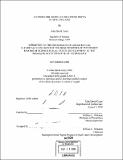| dc.contributor.advisor | William C. Wheaton. | en_US |
| dc.contributor.author | Corey, John David, 1973- | en_US |
| dc.contributor.other | Massachusetts Institute of Technology. Dept. of Architecture. | en_US |
| dc.date.accessioned | 2006-03-29T18:22:30Z | |
| dc.date.available | 2006-03-29T18:22:30Z | |
| dc.date.copyright | 2000 | en_US |
| dc.date.issued | 2000 | en_US |
| dc.identifier.uri | http://hdl.handle.net/1721.1/32186 | |
| dc.description | Thesis (S.M.)--Massachusetts Institute of Technology, Dept. of Architecture, 2000. | en_US |
| dc.description | Includes bibliographical references (leaf 89). | en_US |
| dc.description.abstract | What does the future hold for ski condo prices in New England? To answer this question historical condo prices were collected for The Village of Loon Mountain Development in Lincoln, NH. Skier visits, snowfall, employment, condo stock and interest rate information was also collected from around the region in order to compare changes in these variables with the changes in past ski condo prices. Using over 600 sales transactions from 1977 to 2000, a price index was created. This index allows for a more manageable view of the data as condo location, condo size, and condo style effects were removed using a hedonic model. Remaining was a yearly index that tracked real condo prices as a function of time. Over the length of study, the index had a few years of upward momentum, but all in all real ski condo prices have fallen over the 24 year period. Using the price index, three equations were created that will be the foundation of the econometric model: Skier Visits (a measure of condo demand), Change in Stock (a measure of condo supply) and the Real Price Equation (a measure of condo price). The econometric model uses these three equations to predict future condo supply and demand in order to establish a future price. Five simulations about the future were run to see the affects of changing the input variables. The cases start with pessimistic outlooks on snowfall, resulting in low skier turnout, low new condo supply and further depressing condo prices. Even the most optimistic snowfall case, 90 inches of snow per season, increases demand through skier visits, which in turn prices, starts the construction boom and eventually brings prices back down to pre-boom levels. Case 5, which predicts future snowfall along the linear trend line and doubles forecasted employment growth, forecasts stable condo prices even with a boom in condo construction. Like the other cases, condo stock response immediately to the increase in condo prices; however, with a more robust economy, the prices remain stabilize as more condos come on-line due continued strong demand. This allows for a continued building boom for the foreseeable future. Ultimately what can be concluded from this analysis is that ski condo prices are not going to appreciate. In every simulation, prices either fall or stabilize. Sure there is an instance where prices increase for a year or two, but these ultimately return to preboom levels. Since the ability for developers to supply ski condos quickly, prices will remain flat through 2009. | en_US |
| dc.description.statementofresponsibility | by John David Corey. | en_US |
| dc.format.extent | 89 leaves | en_US |
| dc.format.extent | 7251786 bytes | |
| dc.format.extent | 7260204 bytes | |
| dc.format.mimetype | application/pdf | |
| dc.format.mimetype | application/pdf | |
| dc.language.iso | eng | en_US |
| dc.publisher | Massachusetts Institute of Technology | en_US |
| dc.rights | M.I.T. theses are protected by copyright. They may be viewed from this source for any purpose, but reproduction or distribution in any format is prohibited without written permission. See provided URL for inquiries about permission. | en_US |
| dc.rights.uri | http://dspace.mit.edu/handle/1721.1/7582 | |
| dc.subject | Architecture. | en_US |
| dc.title | Econometric model of ski condo prices in New England | en_US |
| dc.type | Thesis | en_US |
| dc.description.degree | S.M. | en_US |
| dc.contributor.department | Massachusetts Institute of Technology. Department of Architecture | |
| dc.identifier.oclc | 48454339 | en_US |
